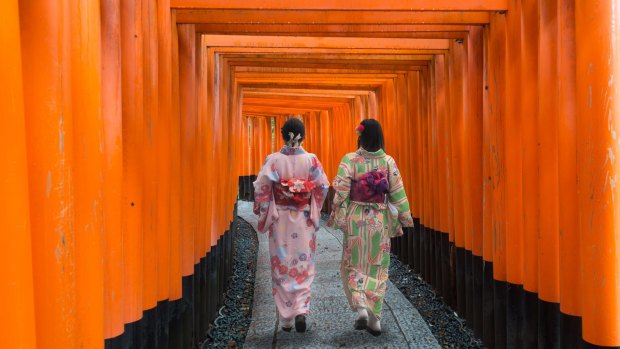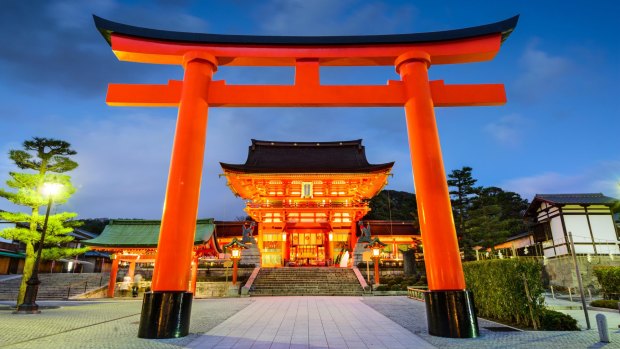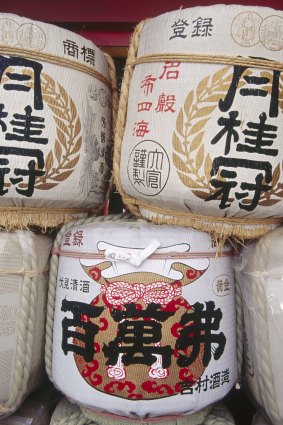This was published 6 years ago
Shinto Buddhist Inari Shrine, Kyoto: dedicated to sake, 'drink of the gods'
By Anthony Dennis
It's the middle of the day and the warm mid-autumn Kyoto sun is beaming down on the thousands of visitors, who can daily descend on the 1300-year-old Shinto Buddhist Inari Shrine. They form a spindly forest of selfie-sticks that's proving as difficult to negotiate as the vestibule of a Tokyo commuter carriage in peak-hour.
Since its establishment in 711AD, the Japanese have been drawn to this shrine, which is one of Kyoto's most iconic and spectacular sights. It is located in a neighbourhood called Fushimi and Japanese go there to pray for harvests, prosperity and family and, I imagine, like me, to have a general sticky-beak.
On a stifling day like this one a pilgrimage can be thirsty work as you pass under and through some of the hundreds, if not thousands, of amber-coloured, arcade-like torii gates that cascade up and down the eponymous mountain that backs the shrine.

Geishas among red wooden torii gates at Fushimi Inari Shrine in Kyoto.Credit: Alamy
It's probably just as well then, what with a stiff drink definitely in order after a visit here, that Inari Shrine should be dedicated to sake, "the drink of the gods" and Japan's national drop. Even better, and utterly unbeknown to most of the tourists here, sake is in abundant supply in the same neighbourhood as the Inari Shrine itself.
Nowadays, visitors come and then they immediately go after visiting the shrine, heading back to Kyoto to tick off some more tourist attractions. Away from shrine, Fushimi is the centre of Kyoto's ancient sake district, home to more than three dozen historic breweries and 20 separate brewers.
One of the two essential components for the brewing of sake, or rice wine, aside from the highest-quality rice, is pristine H₂O. Fushimi is the beneficiary of abundant medium to hard underground spring water that flows from the nearby hills. It's just as well that the supply is plentiful since the painstaking process of sake-making requires more than 14 litres of water in order to produce just under two litres of the vaunted beverage.

The entrance to Fushimi Inari Grand Shrine in Kyoto.Credit: Alamy
Water really is the thing here, I soon discover as I stroll through the streets of Fushimi, coming across gleeful, almost infantile, middle-aged Japanese drinking and bottling free flowing water from a kerb-side stone well drawing water from 50 metres below ground level.
Even in the warmer months the water from a well like this one remains cool and refreshing, containing the small amount of iron that makes it ideal for sake-making and giving the drink its distinctive "smooth and mellow" taste.
Today, the streets of the district still retain some of the atmosphere of the Edo period between the 17th and 19th century, with sake breweries, their dark chocolate burnished facades offset with milky white framed windows and eaves of kura, or warehouses, interspersed with inviting restaurants, bars and shops.

Three traditional sake barrels stacked up outside the temple wall. Credit: Alamy
Nearby, the attractive, tree-shrouded waterways that flow through the town allowed for the transportation of sake to Osaka, the nearby metropolis, and to Kyoto, but they became obsolete when railways and highways were built. These days Fushimi's canals are used for pleasure cruises.
Even if you're not partial to sake, which, despite its global fashionability remains at best an acquired taste for many, it's a fascinating and atmospheric place to wander especially since some of the rice wine breweries now welcome western visitors for tastings and tours.
One such brewery is Shoutoku Shuzo, which has been making premium quality sake "using traditional methods with no additives" since 1645, a pedigree that's not uncommon for many a business here in Japan. The brewery, which sources its rice from a specially-contracted rice farm near Kyoto, is now headed by Maho Otsuka, one of Japan's few female chief sake-makers in what remains a notoriously patriarchal society and industry.
Sake, with an alcohol content roughly the same as grape-based wine, used to be considered a male drink, even though in the Shinto wedding rite it's the drinking of sake that seals the union. But now the industry is striving to appeal more to the lucrative female market, particularly affluent single women, with more attractive labels, style and alcohol content levels.
Sake sales in Japan have been in decline in recent years, having at one point become the second-lowest consumed alcoholic beverage in the country, according to The Japan Times, as younger Japanese have switched their drinking preferences to include western-style fine wines and other drink types.
But the sake industry has worked tirelessly in recent years at developing an export market to offset the decline in domestic consumption. Five per cent of Shoutoku Shuzo's output, for instance, is exported to eager foreign markets such as Australia where interest in Japanese cuisine has grown exponentially in recent years, fuelled by a large increase in the numbers of foreign visitors to Japan.
Even with the decline in domestic sales sake remains an intrinsic part of the Japanese psyche. The Japanese leave offerings beside their own domestic shrines of tiny cups of sake, and kamikaze pilots fortified themselves with sake before embarking on their suicide missions during World War II.
Elsewhere, for the true sake tragics like me, or for those just wanting to gain a better understanding of the somewhat arcane aspects of the drink, Fushimi also features a museum dedicated to the national drop, operated by the Gekkeikan Sake Company, which also dates to the 17th century.
The museum includes an explanation of the history of sake as well as displays of the various implements used in its production. Traditional chants of sake-makers are played throughout the museum, recreating the atmosphere of the sake brewery of the past. But to gain a proper sense of a sake brewery you really need to go inside one, such as Shoutoku Shuzo, which can provide an insight into how sake is made by inoculating steamed white rice with a special mould, allowing fermentation to occur.
From beginning to end, it takes Japan's sake brewers 45 to 60 days to produce sake, according to the classic tome, Japanese Cooking: A simple art, by Shizuo Tsuji. Unlike wine made from grapes, no ageing process is involved, with sake ready to drink as soon as it's produced or within a year of its bottling. Some sake connoisseurs consider it to be at its best three months after bottling.
At Shoutoku Shuzo, which has its own 70-metre-deep well in its front yard that provides all its water needs, I'm taken inside its timber-clad main brewery building with its huge vats of sake. Inside it's cool and dark and to ensure the purity of the sake it's necessary that the brewery remain spotlessly clean.
Eventually, back out into the daylight we convene to a prosaic tasting room to sample the brewery's range of sakes which include the premier "junmai daiginjo-shu", a special high- quality sake made from rice grains "polished" to at least 50 per cent of their original size.
Suffice to say, after a day battling Kyoto's autumnal warmth and its crowds and pounding the rustic pavements of suburban Kyoto these classy Shoutoku Shuzo sakes are the perfect tonic to selfie-sticks and shrine fatigue. Ah, sake, you really are the drink of the gods.
FIVE MORE THINGS TO DO IN FUSHIMI
TAKE LUNCH OR DINNER AT SEIWASO
Tucked away in the middle of suburban Fushimi and apartments the 60-year-old Seiwaso is an exquisite garden and culinary oasis serving refined Kyoto cuisine.See seiwasou.com/en/sp/
VISIT HYAKU-JYO-ZAN GOHYAKU-RAKAN SEKIHOJI TEMPLE
Located a short walk from the Inari Shrine, this temple features the work of artist Jakuchu, who created 500 stone statues set in a shady bamboo grove that recount important stages in the life and death of Buddha.See kyoto.travel/en
TAKE A BOAT RIDE ON THE CANAL
You can gain a different perspective on the sake district from boat ride services that operate throughout all of the four seasons on the canal that runs through the district. See fushimi.or.jp
DRINK AT SAKAGURA KOJI SAKE TAVERN VILLAGE
Secreted away off one of the streets of the sake district, and easy for a foreign visitor to miss, this place is a Japanese-style food court (but don't let that term deter you). See fushimi-sakagura-kouji.com
ESCAPE THE CROWDS AT INARI SHRINE
Simply head further up the mountain, also called Inari and rising to 233 metres above sea level, inside the arcade of torii gates and away from the tourists, and you'll find a semblance of peace and solitude in a beautiful forested setting. See inari.jp/en/
TRIP NOTES
VISIT
Take a train to Fushimi from Kyoto Station on the JR Nara Line. The journey takes about five minutes, with the station located adjacent to the Fushimi Inari Taisha Shrine. You can also take a taxi to Fushimi from anywhere in Kyoto. See inari.jp/en/
FLY
All Nippon Airways (ANA) operates daily flights from Sydney to Tokyo's Haneda Airport with domestic connections to Kansai Airport, which services both Osaka and Kyoto. There are excellent train connections from Kansai Airport to Kyoto Station. See ana.co.jp
TOUR
With its knowledgeable and experienced English-speaking guides in Japan, Experience Japan Travel can tailor a wide of variety of holidays throughout Japan to suit all travel styles and specific interests, including in-depth visits to Kyoto. See experiencejapantravel.com
STAY
The five-star Ritz-Carlton Kyoto is located beside the Kamogawa River and is close to many major attractions. See ritzcarlton.com
Kyoto Iori Machiya Stay offers self-contained, luxuriously-appointed traditional townhouses in central Kyoto. See kyoto-machiya.com
MORE
Anthony Dennis visited Kyoto as a guest of Visit Kyoto, ANA (All Nippon Airways) and Experience Japan Travel.
Sign up for the Traveller Deals newsletter
Get exclusive travel deals delivered straight to your inbox. Sign up now.